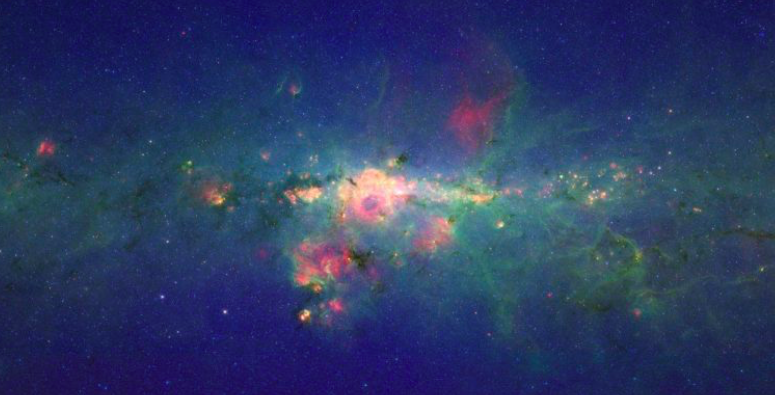As we continue to explore the solar system, our galaxy, and the universe, in general, we encounter things that we can’t comprehend.

The Milky Way’s Center is Shining too Brightly
One such mystery is located at the very heart of the Milky Way Galaxy; there’s something glowing at the center.
According to astronomers, there’s lots more diffuse gamma radiation than what we’re able to explain by what we can observe. It’s dubbed the Galactic Center GeV Excess (GCE), and for years have astronomers tried understanding and explaining what could be powering the excessive energetic light.
A few years ago, in 2015, astronomers leaned towards a generally acceptable explanation: a large population of dim neutron stars was causing the strange glow.
But a new study, published in the pre-print server arXiv casts doubts on that conclusion, and that there may be a flaw in that analysis.
“There’s something happening in the data we don’t understand,” explained Rebecca Leane, a theoretical physicist at the Massachusetts Institute of Technology and co-author of the paper.
It was more than 10 years ago when astronomers using the Fermi Gamma-Ray Space Telescope noticed the center of our galaxy had an excess of gamma radiation

Dark Matter, is that you?
One theory as to why this region glows so bright is that it’s actually created by the destruction of Dark Matter.
Then, astronomers said that the culprit may be millisecond pulsars that somehow eluded detection in previous observations.
But now, dark matter is back in the game. Despite the fact we can’t actually see Dark Matter (Yet) we may have the ability to spot the radiation it produces.
“We discover striking behavior consistent with a mis-modelling effect in the real Fermi data, finding that large artificial injected dark matter signals are completely misattributed to point sources [i.e., millisecond pulsars],” the scientists wrote in their paper, yet to be peer-reviewed.
So how do we know? If dark matter particles dubbed WIMPs, Weakly Interacting Massive Particles, collide against each other, they would basically destroy one another, causing them to explode in a shower of different particles, among which are gamma-ray photons. 🌟
This process should produce a signal that could easily be identified by astronomers: an even distribution of photons.
However, two separate studies performed in the past showed that these photons were not distributed evenly, but rather in clumps.
This created confusion among experts.
This is why they said that the cause of these excessive’glow’ at the center was a group of millisecond pulsars, which are basically neutron stars that rotate extremely fast, at a rate of up to 1,000 times per second.
And while they are to faint to be detected individually, astronomers say that together they produce a diffuse glow.
But… turns out it may not be the answer after all. 🤷♂️
That’s why scientists recently decided to mathematically simulate the Milky Way, including a few more variables like pulsars and dark matter destruction.
They discovered that even though they included dark matter as a source for the Galactic Center GeV Excess (GCE), an analysis still wrongly identified the origin of the glow as millisecond pulsars and gamma radiation from Fermi bubbles exploding due to the supermassive black hole located in our galactic core.
So does this mean it isn’t dark matter?
Not really. Instead, it means that there’ just much more we simply don’t understand.
“Something about our understanding of the gamma rays is missing at this stage,” theoretical astrophysicists Rebecca Leane revealed in an interview with Quanta magazine.
“It’s possible to hide a dark matter signal if it were really there.”
Two additional studies have been published in the pre-print server arXiv that add support to what Leane and Tracy Slatyer of MIT found.
Right now, to find out more about the mysterious glow, we need to wait for the papers to be peer-reviewed, and we can then continue unveiling the mysteries at the center of our galaxy.
The paper has been published on arXiv and can be seen here.
